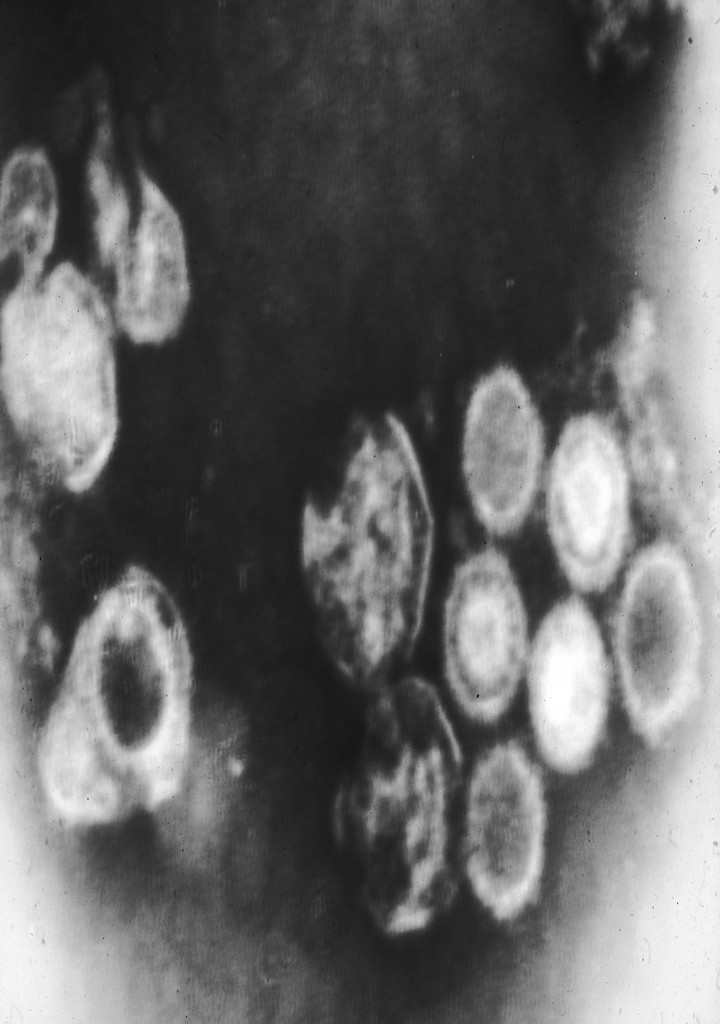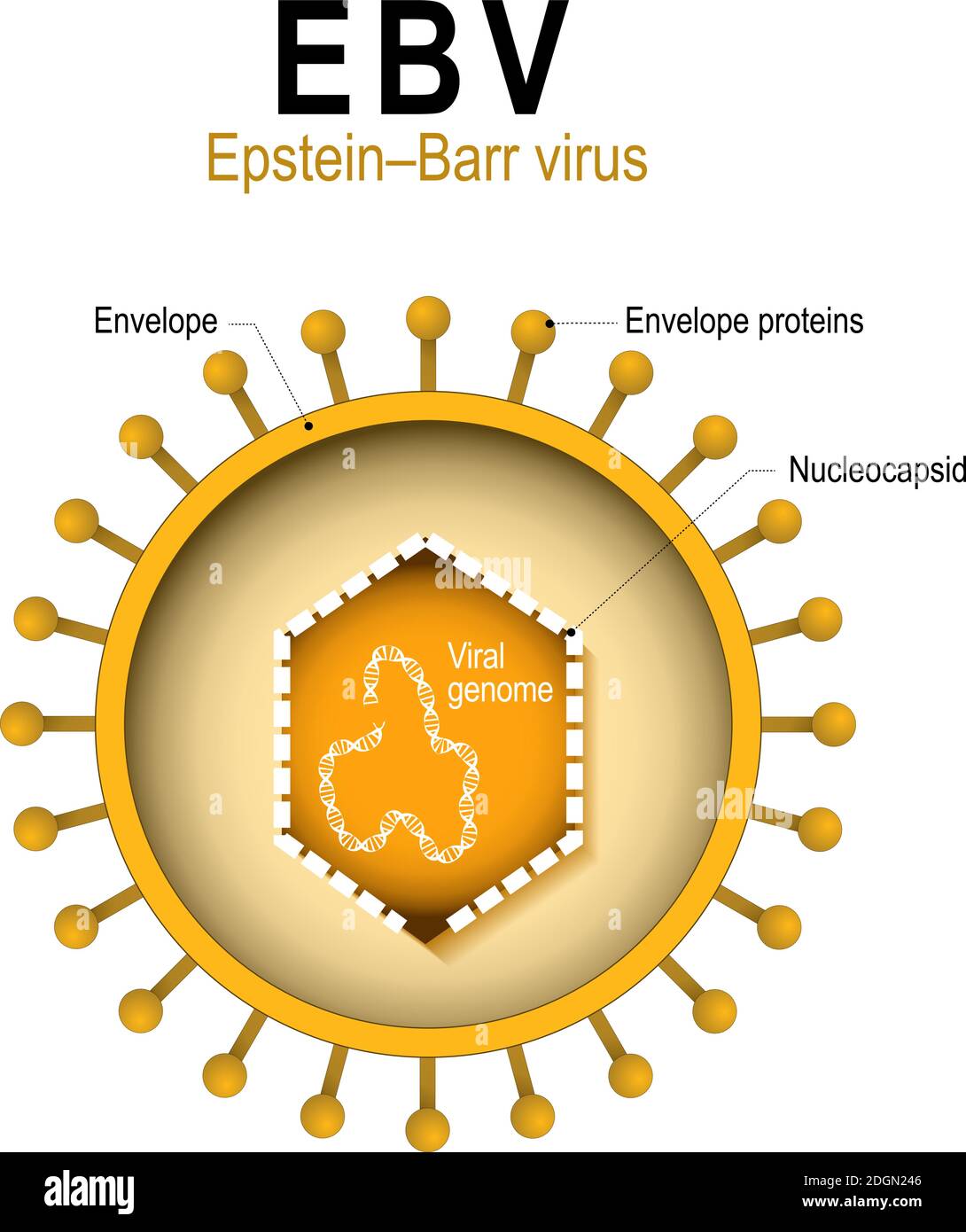Epstein Barr virus (EBV) is a double-stranded DNA virus that infects B lymphocyte cells. It is in the herpesvirus family and was discovered in 1964.[1][2] It can cause a variety of diseases and is spread mainly from saliva containing virus-infected epithelial cells.[1][3] Close to 95% of adults throughout the world have been infected with EBV.[2]
Epstein-Barr virus and MS. There may also be a link between EBV and the autoimmune disease multiple sclerosis (MS). Studies show that people who've had an EBV infection are at much higher risk
Das Epstein-Barr-Virus, kurz EBV, ist der Erreger der infektiösen Mononukleose und ein möglicher Auslöser des Gianotti-Crosti-Syndroms.Es handelt es sich um ein DNA-Virus, das zur Familie der Herpesviridae (Herpesviren) gehört und auch als HHV 4 (Humanes Herpesvirus 4) bezeichnet wird.
The virus was first discovered in 1964 when Sir Michael Anthony Epstein and Ms. Yvonne Barr found it in a Burkitt lymphoma cell line. In 1968, the virus was linked to the disease of infectious mononucleosis (glandular fever).; Infection with Epstein-Barr virus (EBV) is common and usually occurs in childhood or early adulthood.
Epstein-Barr virus (EBV) is a common human herpesvirus, which belongs to the gamma-family of viruses along with one other human virus, Kaposi's sarcoma associated herpesvirus (KHSV). Unlike alpha- and beta-herpesviruses, these viruses share the ability to induce cancer. Indeed, EBV was discovered due to its presence in Burkitt's lymphoma
Epstein-Barr virus and MS. There may also be a link between EBV and the autoimmune disease multiple sclerosis (MS). Studies show that people who've had an EBV infection are at much higher risk Das Epstein-Barr-Virus, kurz EBV, ist der Erreger der infektiösen Mononukleose und ein möglicher Auslöser des Gianotti-Crosti-Syndroms.Es handelt es sich um ein DNA-Virus, das zur Familie der Herpesviridae (Herpesviren) gehört und auch als HHV 4 (Humanes Herpesvirus 4) bezeichnet wird. The virus was first discovered in 1964 when Sir Michael Anthony Epstein and Ms. Yvonne Barr found it in a Burkitt lymphoma cell line.
In 1968, the virus was linked to the disease of infectious mononucleosis (glandular fever).; Infection with Epstein-Barr virus (EBV) is common and usually occurs in childhood or early adulthood. Epstein-Barr virus (EBV) is a common human herpesvirus, which belongs to the gamma-family of viruses along with one other human virus, Kaposi's sarcoma associated herpesvirus (KHSV). Unlike alpha- and beta-herpesviruses, these viruses share the ability to induce cancer. Indeed, EBV was discovered due to its presence in Burkitt's lymphoma
Most people are infected by the Epstein-Barr virus (EBV) in early childhood. It usually causes no symptoms or only a brief, mild illness. When teens or young adults become infected, it can cause infectious mononucleosis, or "mono." The symptoms of mono are extreme fatigue, fever, sore throat, and swollen lymph nodes.
The role of Epstein-barr virus in neurological diseases. EBV can infect the organism directly, or indirectly via infection of B cells interact with host cells via its own encoded proteins (EBNA1, LMP1, LMP2A, etc.) and miRNAs to promote inflammation and regulate the immune response, and participate in the development of neurological disorders.(A) EBV-positive/infected B cells used the viral
Das Epstein-Barr-Virus (EBV) ist in der deutschen Bevölkerung sehr weit verbreitet und enorm ansteckend. Es gehört zu der Gruppe der Herpesviren. Das Epstein-Barr-Virus ist der Auslöser der infektiösen Mononukleose, die auch als Pfeiffersches Drüsenfieber bekannt ist. Darüber hinaus kann EBV aber noch weitere Krankheiten auslösen.
The Epstein-Barr virus, also called EBV, is an extremely common virus that infects most people at one time or another during their lifetimes. Epstein-Barr virus infection generally causes a minor cold-like or flu-like illness, but, in some cases, there may be no symptoms of infection.
Epstein Barr Virus- Symptoms, Causes, Treatments - Healthgrades
Most people are infected by the Epstein-Barr virus (EBV) in early childhood. It usually causes no symptoms or only a brief, mild illness. When teens or young adults become infected, it can cause infectious mononucleosis, or "mono." The symptoms of mono are extreme fatigue, fever, sore throat, and swollen lymph nodes. The role of Epstein-barr virus in neurological diseases. EBV can infect the organism directly, or indirectly via infection of B cells interact with host cells via its own encoded proteins (EBNA1, LMP1, LMP2A, etc.) and miRNAs to promote inflammation and regulate the immune response, and participate in the development of neurological disorders.(A) EBV-positive/infected B cells used the viral Das Epstein-Barr-Virus (EBV) ist in der deutschen Bevölkerung sehr weit verbreitet und enorm ansteckend.
Es gehört zu der Gruppe der Herpesviren. Das Epstein-Barr-Virus ist der Auslöser der infektiösen Mononukleose, die auch als Pfeiffersches Drüsenfieber bekannt ist. Darüber hinaus kann EBV aber noch weitere Krankheiten auslösen. The Epstein-Barr virus, also called EBV, is an extremely common virus that infects most people at one time or another during their lifetimes. Epstein-Barr virus infection generally causes a minor cold-like or flu-like illness, but, in some cases, there may be no symptoms of infection.
Das Epstein-Barr-Virus (EBV, auch Humanes Herpesvirus 4, HHV4, engl. Human gammaherpesvirus 4) ist eine Spezies humanpathogener, behüllter, doppelsträngiger DNA-Viren aus der Familie der Orthoherpesviridae. Erstmals beschrieben wurde das Epstein-Barr-Virus 1964 von Anthony Epstein, Yvonne Barr und Bert Achong.
Epstein-Barr virus (EBV) is a common and highly contagious herpes virus that spreads through bodily fluids like saliva. About 90% of adults have had an EBV infection at some point.
The Epstein-Barr virus (EBV), like other viruses, is a microscopic agent that can only survive and replicate by infecting a host. EBV is grouped with similar viruses categorized as double-stranded DNA viruses. EBV is in the herpes family of viruses. It is sometimes referred to as human herpesvirus 4.
Epstein-Barr virus (EBV) can cause illnesses and complications aside from infectious mononucleosis. EBV infection can affect a person's brain, spinal cord, and nerves. People with weakened immune systems may develop more severe illness caused by EBV infection.
Clinical Overview of Epstein-Barr Virus (EBV) | EBV and Mono - CDC
Das Epstein-Barr-Virus (EBV, auch Humanes Herpesvirus 4, HHV4, engl. Human gammaherpesvirus 4) ist eine Spezies humanpathogener, behüllter, doppelsträngiger DNA-Viren aus der Familie der Orthoherpesviridae. Erstmals beschrieben wurde das Epstein-Barr-Virus 1964 von Anthony Epstein, Yvonne Barr und Bert Achong. Epstein-Barr virus (EBV) is a common and highly contagious herpes virus that spreads through bodily fluids like saliva. About 90% of adults have had an EBV infection at some point.
The Epstein-Barr virus (EBV), like other viruses, is a microscopic agent that can only survive and replicate by infecting a host. EBV is grouped with similar viruses categorized as double-stranded DNA viruses. EBV is in the herpes family of viruses. It is sometimes referred to as human herpesvirus 4. Epstein-Barr virus (EBV) can cause illnesses and complications aside from infectious mononucleosis.
EBV infection can affect a person's brain, spinal cord, and nerves. People with weakened immune systems may develop more severe illness caused by EBV infection.
Epstein-Barr virus (EBV) is a ubiquitous virus that infects at least 95% of the population. Most persons are infected during infancy and early childhood and are asymptomatic or have nonspecific symptoms ().Infection of adolescents and young adults with EBV often results in infectious mononucleosis with fever, lymphadenopathy, sore throat, and splenomegaly.
Epstein-Barr virus, virus of the Herpesviridae family that is the major cause of acute infectious mononucleosis, a common syndrome characterized by fever, sore throat, extreme fatigue, and swollen lymph glands. Learn about the characteristics and growth cycle of EBV and disorders linked to the virus.
Epstein-Barr virus. Epstein-Barr virus (EBV) is part of the family of human herpes viruses. Infectious mononucleosis (IM) is the most common disease manifestation of this virus which, once established in the host, can never be completely eradicated. Very little can be done to treat EBV; most methods can only alleviate resultant symptoms.
Epstein-Barr virus, or EBV, is one of the most common human viruses in the world. EBV is also known as human herpesvirus 4 and is a member of the herpes virus family. Most people will get infected with EBV in their lifetime, especially in childhood, and will not have symptoms. EBV infections in children usually do not cause symptoms, or the
About Epstein-Barr Virus (EBV) | EBV and Mono | CDC
Epstein-Barr virus (EBV) is a ubiquitous virus that infects at least 95% of the population. Most persons are infected during infancy and early childhood and are asymptomatic or have nonspecific symptoms ().Infection of adolescents and young adults with EBV often results in infectious mononucleosis with fever, lymphadenopathy, sore throat, and splenomegaly. Epstein-Barr virus, virus of the Herpesviridae family that is the major cause of acute infectious mononucleosis, a common syndrome characterized by fever, sore throat, extreme fatigue, and swollen lymph glands. Learn about the characteristics and growth cycle of EBV and disorders linked to the virus. Epstein-Barr virus.
Epstein-Barr virus (EBV) is part of the family of human herpes viruses. Infectious mononucleosis (IM) is the most common disease manifestation of this virus which, once established in the host, can never be completely eradicated. Very little can be done to treat EBV; most methods can only alleviate resultant symptoms. Epstein-Barr virus, or EBV, is one of the most common human viruses in the world. EBV is also known as human herpesvirus 4 and is a member of the herpes virus family.
Most people will get infected with EBV in their lifetime, especially in childhood, and will not have symptoms. EBV infections in children usually do not cause symptoms, or the
The Epstein-Barr virus (EBV) is a type of herpes virus that causes infections in those affected. EBV infections can cause a sore throat, headache, and swollen lymph nodes, among other symptoms.
A person can acquire Epstein-Barr virus (EBV) via contact with body fluids, particularly saliva. While most people will contract EBV at some point, many will not experience any symptoms.
Epstein-Barr virus, EBV, is a member of the Herpesvirus family, and is one of the most common human viruses. When infection with EBV occurs during adolescence or young adulthood, it causes infectious mononucleosis 35% to 50% of the time. (CDC)
Epstein-Barr virus, which causes mono, is an oncovirus. This means that having mono or another infection caused by EBV may put you at a higher risk of some types of cancer. EBV infection increases a person's risk of getting nasopharyngeal cancer,
What Is Epstein-Barr Virus and How Can It Impact Cancer Risk?
The Epstein-Barr virus (EBV) is a type of herpes virus that causes infections in those affected. EBV infections can cause a sore throat, headache, and swollen lymph nodes, among other symptoms. A person can acquire Epstein-Barr virus (EBV) via contact with body fluids, particularly saliva. While most people will contract EBV at some point, many will not experience any symptoms. Epstein-Barr virus, EBV, is a member of the Herpesvirus family, and is one of the most common human viruses.
When infection with EBV occurs during adolescence or young adulthood, it causes infectious mononucleosis 35% to 50% of the time. (CDC) Epstein-Barr virus, which causes mono, is an oncovirus. This means that having mono or another infection caused by EBV may put you at a higher risk of some types of cancer. EBV infection increases a person's risk of getting nasopharyngeal cancer,
Epstein-Barr virus is in the human herpesvirus family and is also known as human herpesvirus Symptoms of EBV are not the same as other viruses in the herpesvirus family like genital herpes . There are several common conditions that are in the human herpes virus family like chickenpox , shingles and mononucleosis.
The Epstein-Barr virus (EBV) is one of the nine known human herpesvirus types in the herpes family, and is one of the most common viruses in humans. EBV is a double-stranded DNA virus and is also called human herpesvirus 4 (HHV-4). [2] Epstein-Barr virus (EBV) is the first identified oncogenic virus, or a virus that can cause cancer.EBV establishes permanent infection in humans.
Epstein-Barr virus (EBV) is the first identified human oncogenic virus that can establish asymptomatic life-long persistence. It is associated with a large spectrum of diseases, including benign diseases, a number of lymphoid malignancies, and
The Epstein-Barr virus , or human herpesvirus 4, is one of eight types of herpes viruses that are known to infect humans. EBV is extremely common: it is estimated that up to 90% of adults worldwide carry the virus [1, 2]. The virus usually does not cause any symptoms in children.
Epstein Barr Virus (EBV) Tests & Result Interpretation
Epstein-Barr virus is in the human herpesvirus family and is also known as human herpesvirus Symptoms of EBV are not the same as other viruses in the herpesvirus family like genital herpes . There are several common conditions that are in the human herpes virus family like chickenpox , shingles and mononucleosis. The Epstein-Barr virus (EBV) is one of the nine known human herpesvirus types in the herpes family, and is one of the most common viruses in humans. EBV is a double-stranded DNA virus and is also called human herpesvirus 4 (HHV-4). [2] Epstein-Barr virus (EBV) is the first identified oncogenic virus, or a virus that can cause cancer.EBV establishes permanent infection in humans.
Epstein-Barr virus (EBV) is the first identified human oncogenic virus that can establish asymptomatic life-long persistence. It is associated with a large spectrum of diseases, including benign diseases, a number of lymphoid malignancies, and The Epstein-Barr virus , or human herpesvirus 4, is one of eight types of herpes viruses that are known to infect humans. EBV is extremely common: it is estimated that up to 90% of adults worldwide carry the virus [1, 2]. The virus usually does not cause any symptoms in children.




